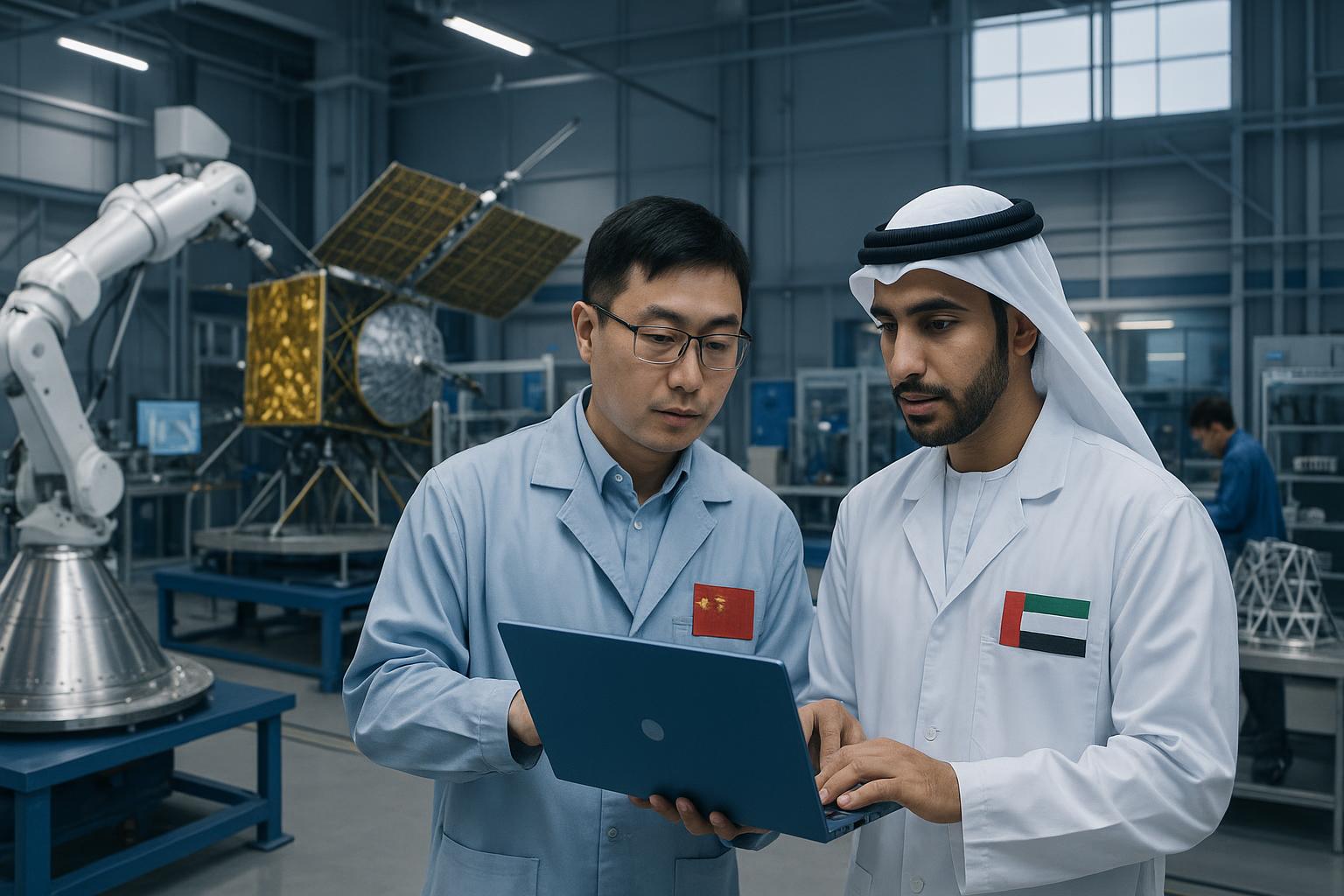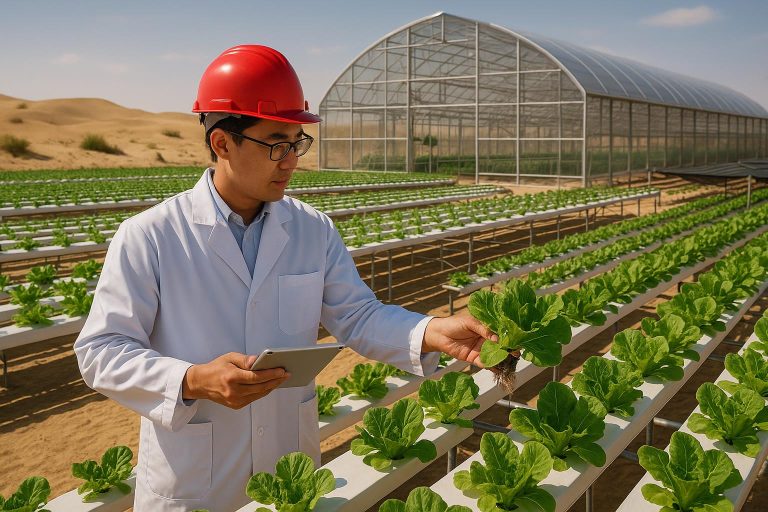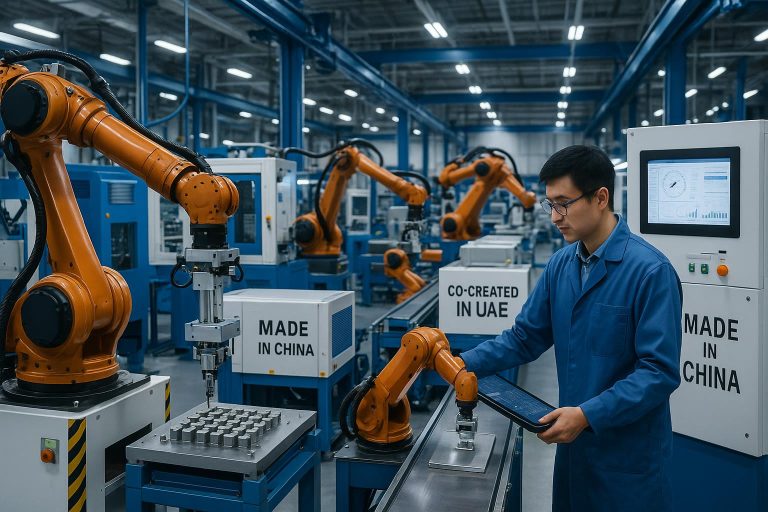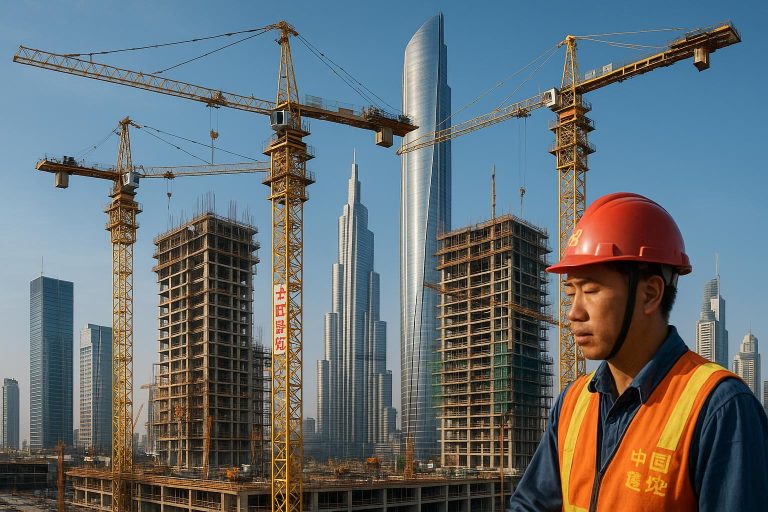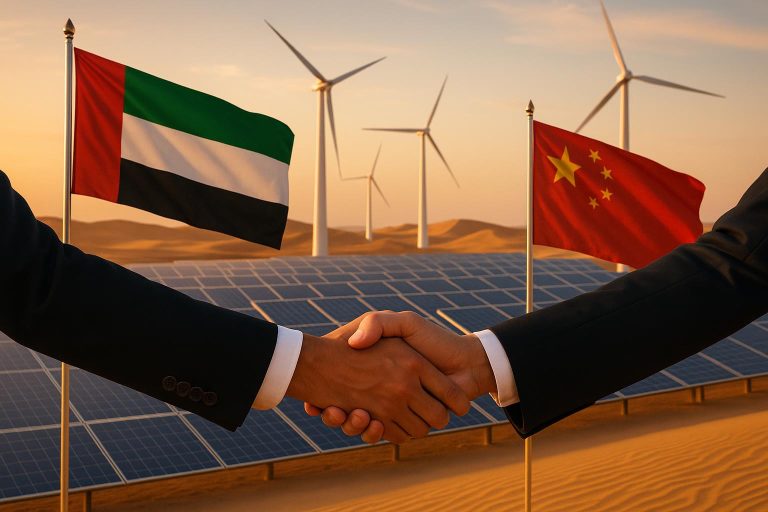Reaching for the Stars: Exploring Sino-UAE Collaboration in the Aerospace and Advanced Materials Industries
Executive Summary
The United Arab Emirates (UAE) and China have cultivated a robust and rapidly expanding bilateral relationship, evolving from a trade-focused partnership to a comprehensive strategic alliance. This transformation is increasingly evident in high-tech sectors such as aerospace and advanced materials, where joint ventures and collaborative projects are beginning to flourish. This article examines the current landscape of Sino-UAE cooperation in these critical industries, identifying key growth drivers, opportunities, and potential challenges. Through an analysis of strategic agreements, investment trends, and a case study spotlight, the article explores how this partnership is poised to reshape the future of high-tech development in both nations. As the UAE continues its strategic pivot towards a knowledge-based economy and China advances its global technological ambitions, the aerospace and advanced materials sectors represent a frontier of immense potential, promising significant mutual benefits and long-term strategic value. This analysis concludes with strategic recommendations for maximizing the partnership’s potential and navigating the complexities of this dynamic collaboration.
Introduction
The relationship between the United Arab Emirates (UAE) and the People’s Republic of China has undergone a remarkable transformation, evolving from nascent diplomatic ties to a comprehensive strategic partnership. This evolution is underpinned by shared economic interests, a mutual desire for global influence, and a growing recognition of each other’s strategic importance in a multipolar world. While traditional sectors like energy and trade have historically dominated this bilateral engagement, a new frontier of cooperation is rapidly emerging: the aerospace and advanced materials industries. These sectors are not only pivotal for national security and economic diversification but also represent the cutting edge of technological innovation.
This article delves into the burgeoning collaboration between the UAE and China in aerospace and advanced materials. It aims to provide a nuanced analysis of the current state of this partnership, highlighting the significant opportunities for growth and the strategic drivers propelling this cooperation. Furthermore, it will critically examine the inherent challenges and considerations that both nations must navigate to ensure sustainable and mutually beneficial outcomes. By exploring specific initiatives, investment patterns, and a relevant case study, this analysis seeks to illuminate the potential for this strategic alliance to reach new heights, metaphorically and literally, in the pursuit of technological advancement and economic prosperity.
The Current Landscape of Bilateral Cooperation
The relationship between the UAE and China has matured into a comprehensive strategic partnership, characterized by burgeoning trade, significant investment flows, and increasingly diversified sectoral cooperation. This robust engagement is underpinned by a shared vision for economic growth and regional stability, with both nations actively seeking to leverage each other’s strengths. The quantitative indicators of this partnership are particularly striking, demonstrating an exponential growth trajectory.
Bilateral trade between the two nations reached an unprecedented $101.8 billion in 2024 [1], marking an extraordinary 800-fold increase since 1984. This makes the UAE China’s largest export market in the Middle East and its second-largest trading partner in the region, while China consistently remains the UAE’s largest trading partner. This commercial dynamism is further evidenced by the presence of over 15,000 Chinese firms operating in the UAE [1], contributing significantly to the local economy and fostering cross-cultural business ties. Investment flows are equally impressive, with UAE investments in China reaching $4.5 billion by the end of 2023 [1], representing a substantial 96% increase from the previous year. These figures underscore a deep and expanding economic interdependence that forms the bedrock of their strategic alliance.
Beyond trade and investment, the partnership is formalized through a Comprehensive Strategic Partnership established in 2018 [1], which provides a high-level framework for collaboration across various domains. The formation of the UAE-China Investment and Economic Cooperation Working Group [1] facilitates structured dialogue and policy coordination, ensuring that bilateral initiatives are aligned with national development strategies. Regular high-level diplomatic engagements and strategic agreements further solidify this framework, creating a stable and predictable environment for long-term cooperation.
Cooperation extends across a multitude of sectors, reflecting the diversification efforts of both economies. While Energy & Clean Energy [1] remain foundational, with investments in solar and wind power and the Masdar-China Silk Road Fund MoU for renewable energy projects, new areas are gaining prominence. Infrastructure & Logistics [1] continue to be critical, exemplified by the COSCO terminal at Khalifa Port and the China-UAE Industrial Capacity Zone, positioning the UAE as China’s gateway to the Gulf. Technology & AI [1] are emerging as pivotal sectors, with agreements on digital transformation and AI investments, such as the UAE-China $5 billion partnership for AI, renewable energy, and infrastructure [4]. The UAE’s G42, for instance, is strategically positioned in the global AI landscape, exploring collaborations that span both US and Chinese markets [1].
Further diversification is observed in Healthcare & Pharmaceuticals [1], where entities like Mubadala have acquired significant stakes in Chinese pharmaceutical businesses [6], and cooperation extends to medical technology and biotech. Agriculture & Food Security [1] initiatives, such as the $33 million smart agricultural project between Silal and China’s Shouguang Vegetable Group [7], highlight efforts to enhance food production through advanced technologies like hydroponics. The Aviation & Transportation [1] sector is witnessing significant growth, with Emirates and Air China enhancing partnerships [2], and a notable $1 billion deal for 350 flying taxis (eVTOL aircraft) [3] underscoring a shared vision for future mobility. This is complemented by the expansion of Emirates’ network in mainland China and technical collaborations in aviation [1, 5].
Logistics & Supply Chain [1] are being bolstered by Chinese giants like JINGDONG Property establishing Middle East logistics hubs in Dubai [8], leveraging smart supply chain technologies to reinforce the UAE’s role as a critical regional hub. In Tourism & Hospitality [1], the UAE is actively targeting the Chinese market, with initiatives like the 2025 China-GCC tourism trade fair in Dubai [9] and explorations of investments in resorts and infrastructure. Finally, Financial Services & Fintech [1] are seeing increased collaboration, including cross-border payment cooperation between China’s CIPS and the UAE central bank [10], and joint efforts in fintech partnerships and investment promotion.
Recent developments in 2024-2025 further illustrate the deepening ties, with multiple MoUs signed between various chambers and organizations, and continued high-level visits [1]. These engagements increasingly focus on new economy sectors, entrepreneurship, tourism, and aviation. Geographically, Abu Dhabi serves as a primary investment hub, while Dubai plays a crucial role in trade facilitation, with free zone partnerships extending across various emirates, collectively reinforcing the UAE’s strategic importance in China’s Belt and Road Initiative and broader global outreach [1].
Opportunities and Strategic Growth Drivers
The burgeoning collaboration between the UAE and China in aerospace and advanced materials is driven by a confluence of strategic imperatives and mutual benefits. Both nations recognize the critical role these sectors play in economic diversification, technological sovereignty, and global competitiveness. For the UAE, a key driver is its ambitious vision to transition from a hydrocarbon-dependent economy to a knowledge-based, high-tech powerhouse. China, on the other hand, seeks to expand its global technological footprint, secure supply chains for critical materials, and foster international partnerships that align with its Belt and Road Initiative (BRI).
In the aerospace sector, the opportunities for Sino-UAE collaboration are particularly compelling. The UAE’s strategic geographical location, world-class aviation infrastructure, and its aspiration to become a global aviation hub align perfectly with China’s rapidly expanding aerospace industry and its growing demand for international connectivity. The Emirates and Air China Memorandum of Understanding (MoU) [2] for enhanced partnership and route expansion exemplifies this synergy, promising increased passenger and cargo traffic, which in turn fuels demand for aircraft maintenance, repair, and overhaul (MRO) services, as well as ground support and logistics. The expansion of Emirates’ Chinese mainland network to five gateways, including Hangzhou, further solidifies these operational linkages [1].
A significant strategic growth driver is the shared interest in future mobility solutions. The landmark UAE-China $1 billion deal for 350 flying taxis (eVTOL aircraft) [3] represents a forward-looking investment in urban air mobility. This collaboration is not merely about procurement; it signifies a joint commitment to developing and deploying cutting-edge aerospace technologies. Such projects necessitate extensive research and development in areas like battery technology, lightweight composite materials, autonomous flight systems, and air traffic management, creating a fertile ground for joint innovation centers and technology transfer. The General Civil Aviation Authority (GCAA) delegation to China for technical and commercial aviation collaboration further underscores the depth of this engagement, aiming to harmonize standards and facilitate deeper technical exchanges [5].
The advanced materials industry serves as a foundational pillar for aerospace innovation. The development of lighter, stronger, and more durable materials—such as advanced composites, high-performance alloys, and smart materials—is crucial for enhancing aircraft performance, fuel efficiency, and safety. China possesses significant expertise in materials science and manufacturing capabilities, while the UAE, through entities like Mubadala and its investment arms, has demonstrated a strong appetite for investing in high-tech manufacturing and R&D. Opportunities exist for joint ventures in materials research, production facilities for aerospace-grade components, and the development of sustainable materials for aviation. This could include collaborations on additive manufacturing (3D printing) of aerospace parts, leveraging both nations’ strengths to create resilient and innovative supply chains.
Furthermore, the broader strategic partnership framework, including the Comprehensive Strategic Partnership established in 2018 [1] and the UAE-China Investment and Economic Cooperation Working Group [1], provides a stable and supportive environment for these high-tech collaborations. The substantial increase in UAE investments in China, reaching $4.5 billion by the end of 2023 [1], indicates a growing confidence in China’s technological prowess and market potential. Conversely, China’s investments in the UAE, particularly within free zones and industrial parks like the China-UAE Industrial Capacity Zone, offer platforms for Chinese aerospace and advanced materials companies to establish regional manufacturing and distribution hubs, leveraging the UAE’s connectivity and business-friendly environment. These strategic drivers, combined with a mutual desire for technological leadership and economic resilience, position Sino-UAE collaboration in aerospace and advanced materials for significant growth.
Challenges and Critical Considerations
While the trajectory of Sino-UAE collaboration in aerospace and advanced materials appears promising, it is imperative to acknowledge and critically consider the challenges that could impede its full potential. Navigating these complexities requires strategic foresight, robust diplomatic engagement, and a clear understanding of the geopolitical and economic landscapes both nations operate within. These challenges are not insurmountable but necessitate careful management to ensure the long-term sustainability and mutual benefit of the partnership.
One significant consideration revolves around geopolitical sensitivities and technological independence. The aerospace and advanced materials sectors are often intertwined with national security interests and strategic autonomy. As both the UAE and China seek to enhance their technological capabilities, ensuring that collaborations do not inadvertently compromise national interests or become entangled in broader international rivalries is crucial. This requires transparent frameworks for technology transfer, clear definitions of intellectual property rights, and a balanced approach to partnerships that respects the sovereign objectives of each nation. The UAE’s strategic positioning, for instance, necessitates careful balancing of its relationships with various global powers, including the US and China, particularly in sensitive technology domains.
Intellectual Property (IP) protection and regulatory harmonization present another critical area. As advanced materials and aerospace technologies are often proprietary and represent significant R&D investments, robust mechanisms for IP protection are essential to foster trust and encourage deeper collaboration. Differences in legal frameworks and enforcement practices between the UAE and China could create friction if not proactively addressed. Furthermore, the harmonization of regulatory standards, certification processes, and safety protocols for aerospace products and advanced materials is vital for market access and global competitiveness. Divergent standards could lead to increased costs, delays, and barriers to entry for jointly developed products or services.
Market dynamics and competitive pressures also warrant attention. Both the UAE and China are keen to develop indigenous capabilities in these high-tech sectors. While collaboration can accelerate this process, it also introduces the potential for future competition in global markets. Strategic planning is needed to define complementary roles and avoid direct competition in niche areas, focusing instead on synergistic development that leverages each other’s comparative advantages. For example, the UAE could focus on specialized applications or regional distribution, while China contributes its large-scale manufacturing prowess and R&D capacity.
Finally, human capital development and cultural integration are long-term considerations. The successful execution of complex aerospace and advanced materials projects requires a highly skilled workforce. While both nations are investing heavily in education and training, ensuring a sufficient pool of specialized engineers, scientists, and technicians, particularly those with cross-cultural competencies, is paramount. Bridging cultural differences in business practices, communication styles, and project management approaches will also be crucial for fostering effective joint teams and maximizing productivity. Addressing these challenges proactively will be key to transforming potential obstacles into opportunities for strengthening the Sino-UAE strategic partnership in these cutting-edge industries.
Case Study Spotlight: The eVTOL Aircraft Deal
A compelling illustration of the deepening Sino-UAE collaboration in advanced aerospace and materials is the significant $1 billion deal for 350 flying taxis (eVTOL aircraft) [3]. This agreement, while specific in its immediate application, serves as a powerful microcosm of the broader strategic alignment between the two nations. The development and deployment of electric Vertical Take-Off and Landing (eVTOL) aircraft are at the forefront of urban air mobility, a sector that demands cutting-edge innovation in multiple disciplines.
This initiative directly leverages advancements in advanced materials, as eVTOLs require ultra-lightweight yet robust composite structures to maximize battery efficiency and operational range. Furthermore, it necessitates sophisticated aerospace engineering, including propulsion systems, autonomous flight control, and integrated air traffic management solutions. The collaboration signifies a mutual commitment to pioneering future transportation paradigms and positions both the UAE and China as leaders in this emerging field. It also highlights the UAE’s proactive approach to adopting disruptive technologies and China’s capacity to deliver advanced manufacturing and technological solutions, creating a tangible example of their shared vision for a technologically advanced future.
Future Outlook and Strategic Recommendations
The future outlook for Sino-UAE collaboration in the aerospace and advanced materials industries is exceptionally promising, poised for significant expansion driven by shared strategic objectives and a mutual commitment to innovation. As both nations continue to invest heavily in technological advancement and economic diversification, these sectors will increasingly serve as critical pillars of their comprehensive strategic partnership. The trajectory suggests a move towards deeper integration, co-development, and joint market penetration, particularly in emerging technologies.
For the UAE, continued collaboration with China in these high-tech domains offers a direct pathway to accelerating its economic diversification agenda, fostering a knowledge-based economy, and enhancing its global competitiveness. For China, the UAE provides a strategic gateway to the Middle East, Africa, and Europe, offering robust logistics infrastructure, a business-friendly environment, and a partner committed to long-term strategic cooperation. The ongoing high-level diplomatic engagements and the focus on new economy sectors, entrepreneurship, and aviation underscore this forward-looking perspective.
To maximize the potential of this partnership, the following strategic recommendations are proposed:
- Establish Joint R&D Hubs and Innovation Funds: Create dedicated research and development centers focused on aerospace and advanced materials, co-funded by both governments and private sector entities. These hubs could concentrate on areas such as sustainable aviation fuels, next-generation composite materials, AI-driven aerospace design, and urban air mobility solutions. Joint innovation funds would provide seed capital for startups and collaborative projects, fostering a vibrant ecosystem of innovation.
- Harmonize Regulatory Frameworks and Standards: Proactively work towards aligning regulatory standards, certification processes, and intellectual property protection mechanisms. This harmonization will reduce barriers to market entry, facilitate smoother technology transfer, and build greater trust among collaborating entities. Establishing a joint working group specifically for regulatory alignment in aerospace and advanced materials could be a crucial first step.
- Invest in Specialized Human Capital Development: Launch joint educational and vocational training programs focused on aerospace engineering, materials science, and related high-tech skills. This includes scholarships for students to study in each other’s leading institutions, exchange programs for researchers and engineers, and vocational training initiatives to build a skilled workforce capable of supporting advanced manufacturing and R&D efforts.
- Promote Strategic Co-investment and Joint Ventures: Encourage and facilitate more strategic co-investments and joint ventures between UAE and Chinese companies in both nations. This could involve incentives for companies to establish manufacturing facilities for advanced materials in the UAE or for UAE entities to invest in Chinese aerospace technology firms. The goal should be to create complementary supply chains and shared ownership in critical technological advancements.
- Leverage Digital Transformation and AI: Integrate digital transformation and AI technologies across the aerospace and advanced materials value chains. This includes using AI for predictive maintenance in aviation, optimizing material design and manufacturing processes, and developing smart logistics solutions for aerospace components. The existing UAE-China $5 billion partnership for AI and digital transformation initiatives [4] can serve as a strong foundation for this.
By implementing these recommendations, the UAE and China can further solidify their strategic partnership, driving innovation, economic growth, and mutual prosperity in the critical sectors of aerospace and advanced materials, truly reaching for the stars together.
Conclusion
The strategic partnership between the UAE and China has evolved into a dynamic and multifaceted relationship, extending far beyond traditional trade to encompass cutting-edge sectors like aerospace and advanced materials. This collaboration is not merely transactional but is driven by a shared vision for economic diversification, technological advancement, and global influence. The impressive growth in bilateral trade and investment, coupled with high-level strategic frameworks, underscores the depth and breadth of this engagement.
While significant opportunities exist for further cooperation in areas such as urban air mobility, advanced manufacturing, and joint R&D, both nations must proactively address challenges related to geopolitical sensitivities, intellectual property protection, and regulatory harmonization. By fostering an environment of mutual trust, investing in human capital, and promoting strategic co-investment, the UAE and China can navigate these complexities and unlock the full potential of their partnership. The journey towards reaching for the stars together in aerospace and advanced materials is a testament to their enduring commitment to innovation and shared prosperity, promising a future where their collaborative efforts continue to redefine the boundaries of technological achievement.
References
[1] UAE-China Bilateral Investment Research Findings (Provided Research Document).
[2] Emirates and Air China MoU for enhanced partnership and route expansion (Provided Research Document).
[3] UAE-China $1 billion deal for 350 flying taxis (eVTOL aircraft) (Provided Research Document).
[4] UAE-China $5 billion partnership for AI, renewable energy, and infrastructure (Provided Research Document).
[5] GCAA delegation to China for technical and commercial aviation collaboration (Provided Research Document).
[6] Mubadala acquired 100% ownership of UCB Pharma’s mature business in China (Provided Research Document).
[7] Silal and China’s Shouguang Vegetable Group: $33 million smart agricultural project (Provided Research Document).
[8] JINGDONG Property’s first Middle East logistics hub in Dubai (Provided Research Document).
[9] 2025 China-GCC tourism trade fair in Dubai (Provided Research Document).
[10] China’s CIPS and UAE central bank cross-border payment cooperation (Provided Research Document).

